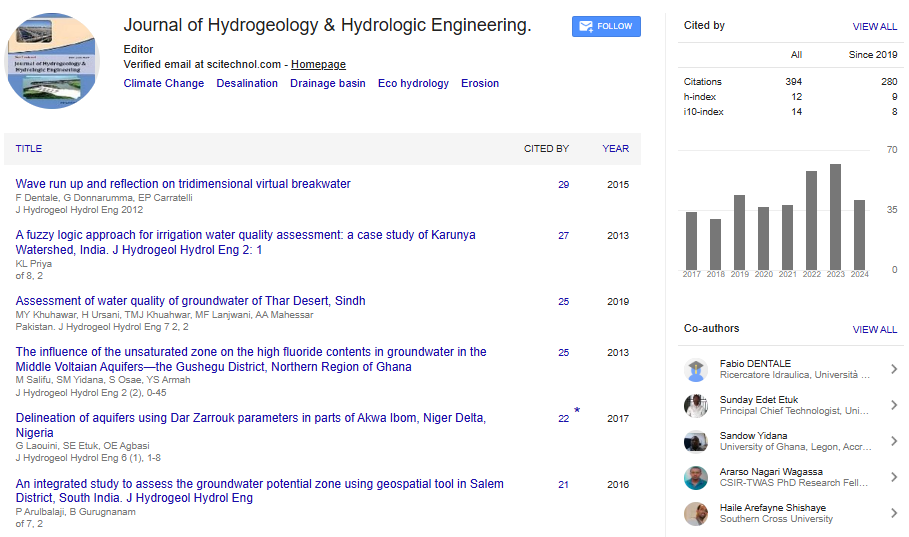Opinion Article, J Hydrogeol Hydrol Eng Vol: 13 Issue: 1
Controlling Erosion and Sedimentation: An All-Inclusive Encyclopaedia for Environmental Sustainability
Qianyang Wang*
1Department of Civil and Environmental Engineering, Clemson University, Clemson, USA
*Corresponding Author: Qianyang Wang,
Department of Civil and Environmental Engineering, Clemson University, Clemson,
USA
E-mail: wangq37@gmail.com
Received date: 22 January, 2024, Manuscript No. JHHE-24-132072;
Editor assigned date: 24 January, 2024, PreQC No. JHHE-24-132072 (PQ);
Reviewed date: 08 February, 2024, QC No. JHHE-24-132072;
Revised date: 16 February, 2024, Manuscript No. JHHE-24-132072 (R);
Published date: 23 February, 2024, DOI: 10.4172/2325-9647.1000309
Citation: Wang Q (2024) Controlling Erosion and Sedimentation: An All-Inclusive Encyclopaedia for Environmental Sustainability. J Hydrogeol Hydrol Eng 13:1.
Description
Erosion and sedimentation control are essential environmental concerns that affect the health of our ecosystems, economies, and societies. Erosion, or the gradual wearing a way of soil or rock by wind or water, can lead to loss of fertile topsoil, decreased soil productivity, and increased sedimentation in waterways, causing habitat destruction and water quality degradation. Sedimentation, or the settling of sediment in water or soil, can also impact water quality and clog waterways, hindering aquatic life and hydropower generation. In this guide, we will discuss effective erosion and sedimentation control measures that can help mitigate these environmental challenges and support sustainable development.
Definition and types of erosion
Water erosion: Caused by rainfall, runoff, or surface water flow, water erosion results in the removal of soil or rock particles by the action of water.
Wind erosion: Caused by wind, this type of erosion involves the removal of soil or sand particles through abrasion or deflation.
Sources of erosion and sedimentation
Land use practices: Deforestation, overgrazing, and poor land management practices can increase soil fragility and susceptibility to erosion.
Construction activities: Building sites, road construction, and excavation can result in sedimentation in waterways.
Agricultural activities: Farming practices, such as tillage, crop rotation, and irrigation, can lead to soil degradation and erosion.
Impacts of erosion and sedimentation
Loss of fertile topsoil: Soil erosion can lead to the loss of nutrientrich topsoil, decreasing soil productivity and food security.
Water quality degradation: Sedimentation in waterways can cloud water, reduce water clarity, and harm aquatic Life.
Economic costs: Erosion and sedimentation can result in expensive environmental cleanup costs, as well as loss of property values and economic productivity.
Soil conservation practices
Terracing: Building terraces or retaining walls can help reduce soil erosion by slowing down water flow and preventing sedimentation.
Contour farming: Planting crops across the slope, rather than up and down it, can reduce soil erosion by minimizing the impact of water flow.
Crop rotation and cover crops: Planting cover crops or rotating crops can help reduce soil erosion by adding organic matter to the soil and holding it in place
Water management practices
Watershed management: Managing water resources within a watershed can help reduce sedimentation by preventing soil erosion and controlling nutrient inputs.
Stormwater management: Implementing stormwater management systems, such as ponds or wetlands, can help reduce sedimentation in waterways.
Watershed restoration: Restoring degraded watersheds through reforestation or habitat creation can help reduce erosion and sedimentation.
Construction practices
Soil erosion control blankets: Using geotextiles or other materials to cover bare soil can help prevent erosion.
Sedimentation control ponds: Building sedimentation ponds at construction sites can help capture sediment before it enters waterways.
Erosion control measures during construction: Implementing measures such as sedimentation basins or silt fences can help prevent sedimentation during construction activities.
National policies and laws
Clean water act: This US federal law regulates discharges of pollutants into navigable waters and sets standards for water quality.
Soil and water conservation act: This US federal law provides funding and technical assistance for soil and water conservation programs.
 Spanish
Spanish  Chinese
Chinese  Russian
Russian  German
German  French
French  Japanese
Japanese  Portuguese
Portuguese  Hindi
Hindi 
